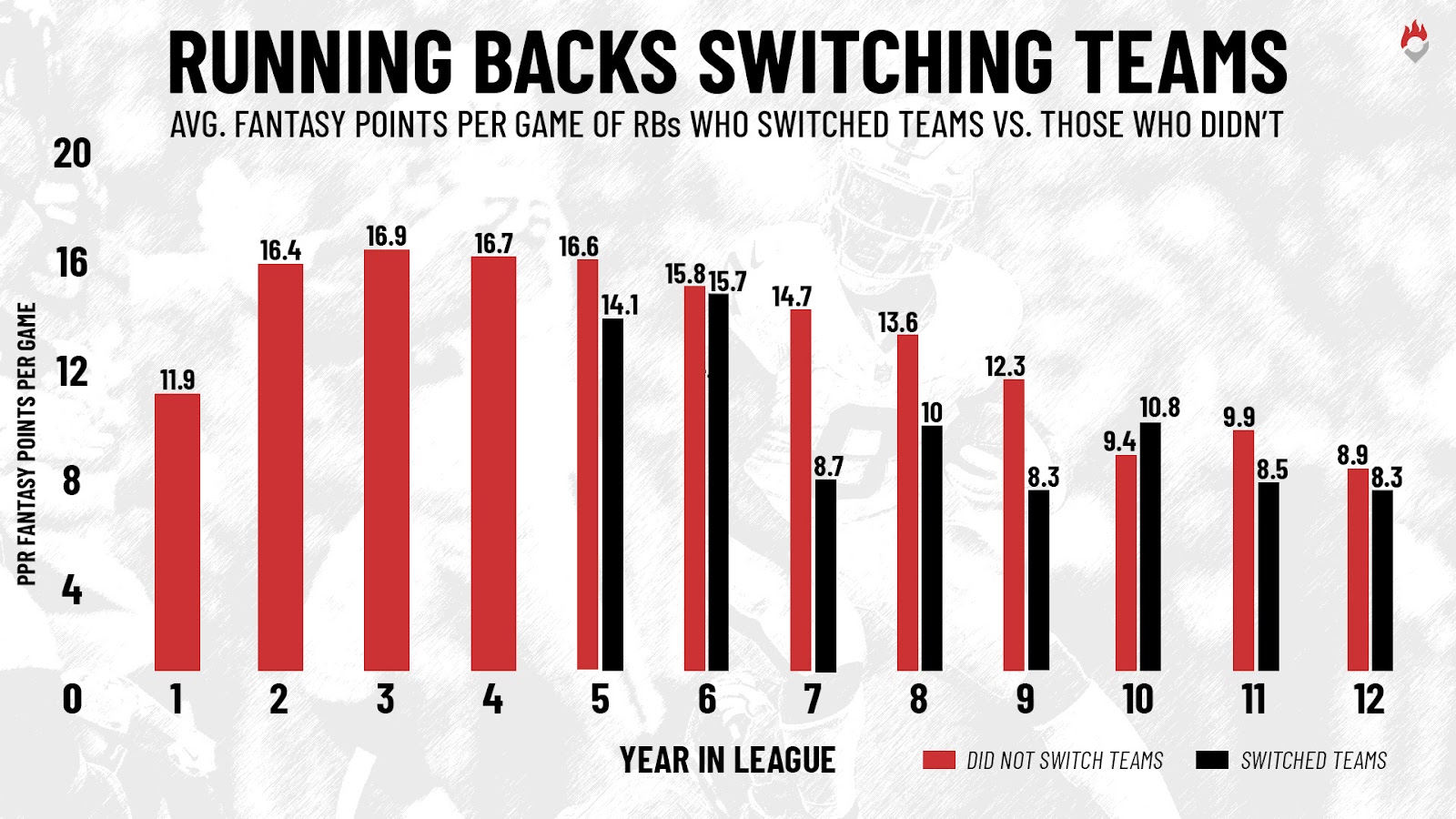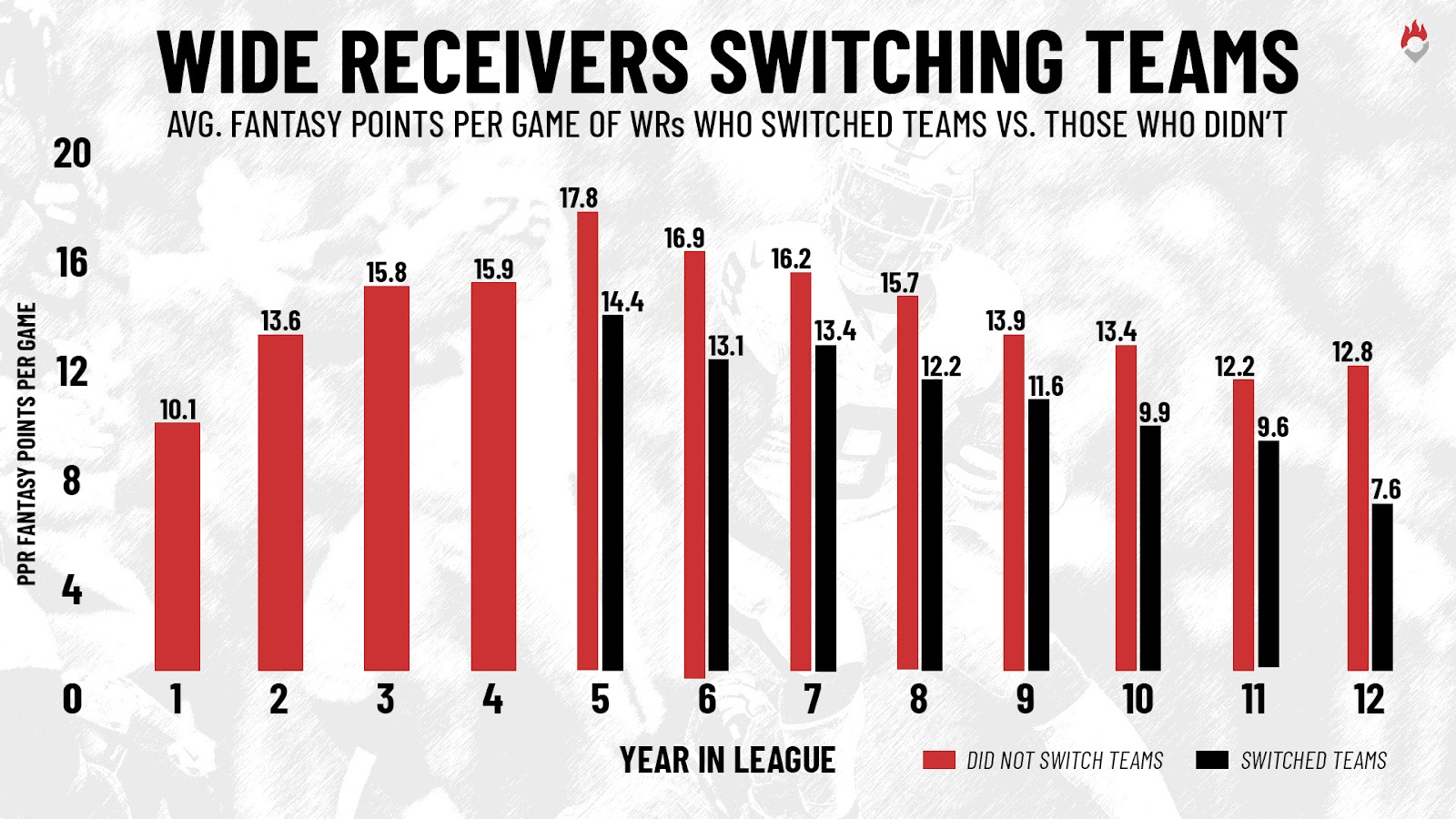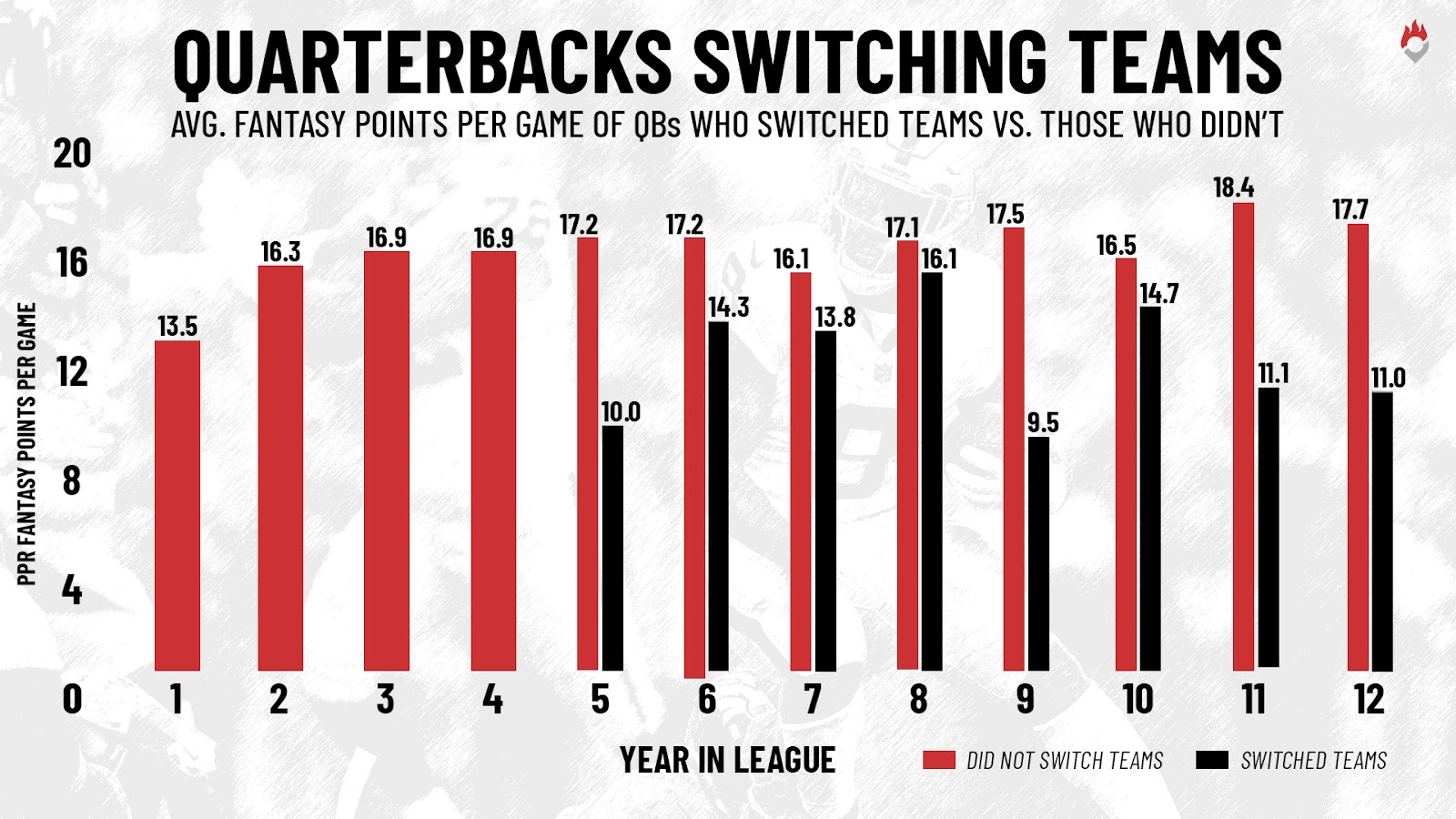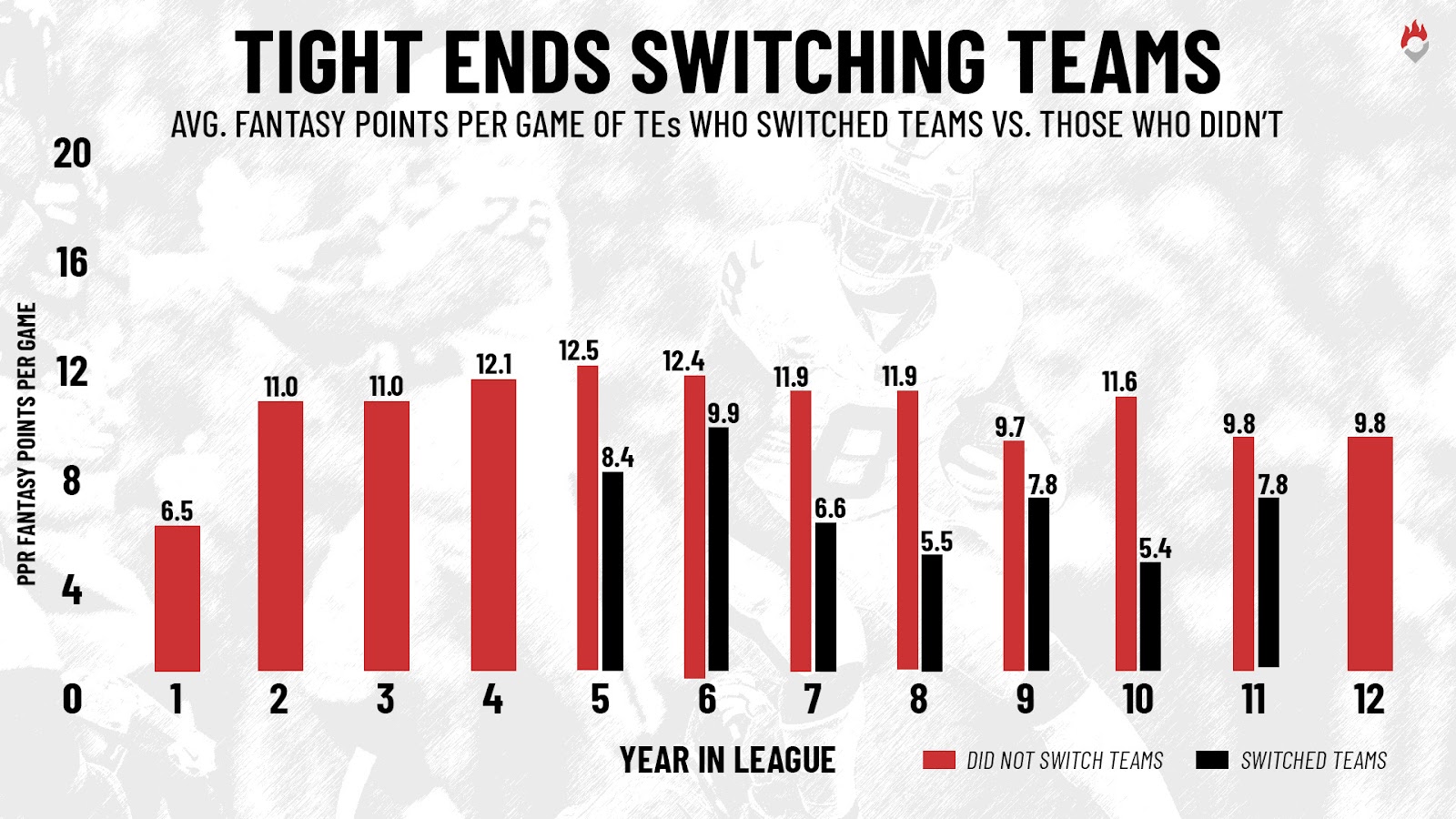I’m always looking for an edge in fantasy football. So, with the annual hype of free agency in full swing, I sought to answer an important question: how well do players perform after switching teams?
How have players who change teams historically performed in fantasy football?
— Ryan Heath (@QBLRyan) March 12, 2024
Since 2016, only 20% beat their positional ADP (compared to 32% of all players).
Though 41% improved their PPR/G from the year before, the market still overvalues them. pic.twitter.com/V6Qe29XHP1
Since 2015, significantly fewer players who changed teams beat their ADP compared to all players. The ADP market therefore frequently overvalues these players, regardless of position. That’s valuable information in itself, and I could have stopped there, but….
Ever since I released Age Curves last summer, I can’t help but see a lot of things in fantasy football through the lens of career arcs. Though we can make good predictions about how long most RBs, WRs, and TEs will remain high-end fantasy producers, calling your shot on the exact season a particular bell-cow RB will fall apart is incredibly difficult and important. So why don’t we ask what his team thinks?
RUNNING BACKS CHANGING TEAMS
Below, we have an illustration of the career arc of RBs with multiple top-12 fantasy seasons on their resume. For each season after Career Year 4, we have two averages: one for players who changed teams, and another for players who remained on the same team. Zeroing in on Years 5 through 9 (roughly when RBs are on their second contracts), RBs who change teams perform significantly worse than their peers.
This makes sense on a few different levels. The vast majority of RBs who change teams do so via free agency. If a player reaches free agency (especially in a league where the franchise tag exists), his original team is often saying, “We think this guy is washed.”
Or at least, “We do not believe this player is worth the salary cap space he’ll likely command on the open market, because we have the most information on him of any team in the league, and we don’t like what we see.” And as is apparent from the graphic above, the team is usually right. In the same way that a player’s draft capital is a signal of how much the NFL likes them, their team declining to tag or re-sign them also contains a signal fantasy managers too often ignore.
Why doesn’t this logic seem to apply to Year 6? Most rookie contracts in the NFL are four seasons long, so the majority of RBs will first hit free agency before Year 5. If they didn’t until Year 6, it usually means one of two things:
The RB’s team was impressed enough to pick up their fifth-year option (if they were originally drafted in Round 1 ) — this was the case for Melvin Gordon and Todd Gurley, though they had the two least productive seasons of the group.
The RB was already on their second contract but was traded to a team willing to give up assets for the right to continue paying that contract — this was the case for David Johnson, DeMarco Murray, Reggie Bush, and Christian McCaffrey. Murray and McCaffrey had by far the best seasons of this group, so this scenario seems the most ideal.
In either case, one team or another has, in fact, given a ringing endorsement to most RBs who change teams in Year 6, based largely on the reality of how NFL contracts are structured. Therefore, many of the RBs changing teams under those specific circumstances could still have productive seasons ahead of them.
Of course, other plausible explanations exist for the overall phenomenon besides teams being good at self-scouting. NFL GMs tend to prioritize drafting players who fit their team’s scheme, so it’s no surprise many of them underperform when they sign with a new team that often employs an entirely different scheme. Then, the player may adjust to their new surroundings after the first year of their new contract, improving their fantasy scoring as they re-enter the “did not change teams” category the following season.
And don’t think for a moment that RBs are the only ones who are in trouble if they change teams. The same trend holds across positions, for largely the same reasons.
WIDE RECEIVERS CHANGING TEAMS
Switching teams via free agency can put WRs on the fast track to the end of their primes as well. However, it’s worth noting that star WRs who are traded have excellent recent track records — DeAndre Hopkins (in Arizona), Stefon Diggs, A.J. Brown, Tyreek Hill, D.J. Moore, and Amari Cooper have all elevated their new offenses while maintaining or improving upon their previous production.
But the fact that a team traded assets for the right to pay each of these players throughout their second or third contract only furthers the previous point. If a WR hits free agency in today’s pass-happy league without their original team or another swooping in beforehand, that’s a bad signal about their remaining ability and/or health.
QUARTERBACKS CHANGING TEAMS
The QB position is driven much more by efficiency, individual talent, and scheme fit than any other position in fantasy football. That makes me more hesitant to take a broad stance, but based on the data, changing teams is a negative signal for QBs at all points in their careers. For me to buy into a QB in a new home, the talent, weapons, and scheme fit need to be exceptional.
Teams will be far less willing to allow good QBs to hit free agency than good RBs, with extreme salary cap situations the most frequent culprit. If a rare QB with elite recent production changes teams as a result of these circumstances, the above graphic may not represent their range of outcomes as closely.
TIGHT ENDS CHANGING TEAMS
I’d be most afraid of spending significant draft capital on a TE who is changing teams. The franchise tag is an especially amazing deal (for teams) when used on the TE position, so any players hitting the open market are likely even less impressive. This rings so true in 2024’s TE free-agent class that it’s barely even worthy of discussion; if Gerald Everett or Mike Gesicki somehow begin to catch steam this summer, remember this.
Let’s examine some players at the more talent-filled positions who are already on the move this offseason. I’m rather pessimistic about most of these situations given all we’ve talked about — that the ADP market generally overrates these players and that changing teams is a sign of poorly aging — but market forces also could well turn some of these players into values as the offseason goes on.
Derrick Henry, RB, Baltimore Ravens Entering: Career Year 9, 2023 FPG Rank: RB16, 2024 ADP: RB14
Why they let him go: Henry finally slowed down in 2023, playing just 53.4% of the Titans’ snaps (27th) and averaging only 13.2 XFP/G (23rd), down from 16.9 (6th). His efficiency was fine — his 0.23 missed tackles forced per attempt (MTF/A) ranked top-20 — but he lost out on volume, even if many of the snaps he missed were “empty-calorie” pass-blocking reps. The Titans seem to have deliberately limited his playing time based on concerns about how well he would physically hold up.
What to expect in his new home: Ravens RBs totaled 45 rush attempts inside the 10-yard line last year, nearly double what Henry saw on the Titans’ anemic offense. Henry is a risky selection given that RBs changing teams in Year 9 average just 8.3 FPG, as well as the evidence that the Titans did not believe he could play a full complement of snaps. But the Ravens’ efficient running game could provide the exact environment and role he needs to thrive at this later stage of his career.
Saquon Barkley, RB, Philadelphia Eagles Entering: Career Year 7, 2023 FPG Rank: RB9, 2024 ADP: RB7
Why they let him go: My read was that the Giants were philosophically opposed to paying an RB what Barkley was looking for ($26 million guaranteed), instead signing Devin Singletary for just under $10 million guaranteed. Barkley has also suffered several ankle injuries over his career, but he bounced back adequately in 2023, averaging 0.18 MTF/A (21st) and a 5.6% explosive play rate (10th) after returning.
What to expect in his new home: Jalen Hurts outrushed D’Andre Swift 16-14 inside the five-yard line last year, calling Barkley’s TD equity into question despite the massive offensive upgrade. RBs switching teams in Year 7, as Barkley is doing, fared much worse than those in Years 5 and 6, averaging 6.0 fewer FPG than their non-switching contemporaries. I could always be sympathetic to an upside argument for a physical freak like Barkley (who could well be the manifestation of Kellen Moore’s vision for this offense, as Philly’s version of CMC), but there will be a lot of downside risk if his ADP settles anywhere near Round 1.
After the uncharacteristic Saquon Barkley signing by the Eagles...
— Ryan Heath (@QBLRyan) March 13, 2024
I'm reminded of what Tony Pollard told @RotoPat and @CDCarter13 about new Eagles OC Kellen Moore.
"With Kellen, we were more 'run the ball to open up the pass game.'"https://t.co/xmAnTeQi2Q via @YouTube
Josh Jacobs, RB, Green Bay Packers Entering: Career Year 6, 2023 FPG Rank: RB18, 2024 ADP: RB10
Why they let him go: Jacobs is coming off career lows in yards per attempt (YPA), MTF/A, and yards after contact per attempt (YACO/A), ranking 6th-worst among 44 qualifying RBs in the latter. He does not get a pass for changing teams in Year 6, as he was not traded like the most successful examples discussed above.
What to expect in his new home: Jacobs has a lengthy track record of operating as a three-down bell cow (he averaged 17.0 XFP/G last year, 4th-most), but I’m skeptical the Packers will deploy him in this manner given how they’ve handled Aaron Jones for years. Jacobs’ contract reportedly has no guaranteed money after Year 1, so I would also not be surprised to see the Packers add more depth to this backfield via the Draft, despite A.J. Dillon already re-joining the team.
Tony Pollard, RB, Tennessee Titans Entering: Career Year 6, 2023 FPG Rank: RB23, 2024 ADP: RB20
Why they let him go: Like Jacobs, Pollard is also coming off career lows in most efficiency stats, including just 0.15 MTF/touch (8th-worst).
What to expect in his new home: Unlike Jacobs, the dip in efficiency came during Pollard’s first-ever season of handling 250+ carries, a fact that shouldn’t be lost on the Titans. A timeshare is likely in the cards, and an offense led by Will Levis can’t be expected to provide Pollard with anywhere close to the 61 red zone carries (2nd-most) he saw last year.
Austin Ekeler, RB, Los Angeles Chargers Entering: Career Year 8, 2023 FPG Rank: RB21, 2024 ADP: RB24
Why they let him go: Ekeler ranked 6th-worst in MTF/touch last year, two spots below Pollard. Though Ekeler was far from the Chargers’ only problem on offense, he never seemed to fully shake his early-season high-ankle sprain and saw his target share dip from 17.3% (2nd-best in 2022) to 13.7% (8th).
What to expect in his new home: I’m open to Ekeler succeeding in real life as a scatback with the Commanders, but he’s unlikely to pick up the goal-line work that made him into a fantasy star with the Chargers, especially with the bigger-bodied incumbent Brian Robinson around. RBs who change teams in Year 8 average -26.5% fewer FPG than those who do not.
D’Andre Swift, RB, Chicago Bears Entering: Career Year 5, 2023 FPG Rank: RB24, 2024 ADP: RB28
Why they let him go: Swift ranked 9th-worst in yards after contact per touch (2.35) among 56 qualifying RBs last year. The Eagles had grander plans to add a high-end starter at the position, which Swift did not fit into
What to expect in his new home: The Bears’ backfield is shaping up to be just as messy as in 2023, with Khalil Herbert and Roschon Johnson also competing for touches. Culture fit is also ever a concern for Swift, whom the Lions’ coaching staff previously seemed to believe lacked toughness.
Aaron Jones, RB, Minnesota Vikings Entering: Career Year 8, 2023 FPG Rank: RB26, 2024 ADP: RB16
Why they let him go: This is a bit unclear, as Jones was more efficient than Jacobs last season on paper, and signed a one-year deal for less money than the Packers shelled out for Jacobs. Jones is aging, and the team has always limited his reps, so they could very well have had concerns about Jones’ ability to hold up physically for another year. Fantasy managers should keep that in mind.
What to expect in his new home: The Vikings recently released Alexander Mattison, but head coach Kevin O’Connell was effusively praising Ty Chandler only a couple of weeks ago at the NFL Combine. Chandler’s 1.53 YPRR (11th-best) was nearly as good as Jones’ last year (8th-best), so I would not rule out Chandler playing a role on passing downs. The offense’s overall ceiling with Sam Darnold under center is another concern.
Joe Mixon, RB, Houston Texans Entering: Career Year 8, 2023 FPG Rank: RB11, 2024 ADP: RB21
Why they let him go: Given that Mixon was a long-rumored cut candidate dating back to last year, from the Bengals’ point-of-view, I’d more-or-less consider this a cut and subsequent free agent signing despite a 7th-round pick changing hands. The team seems content with a platoon at the position after Chase Brown flashed 5.78 yards per touch (6th-best) on limited work as a rookie, having also added Zack Moss (an excellent scheme fit) for about half the 2024 cap hit Mixon would have had.
What to expect in his new home: The Texans have a radically different point of view on Mixon, having just shelled out $13 million guaranteed to him in a new contract. Houston runs a similar zone-blocking scheme to the Bengals, so they likely see Mixon as an upgrade over Dameon Pierce, who struggled to pick it up last year. Though the Bengals could very well be correct that Mixon is washed, this spot stands out to me as one where the upside could be tempting at the lower price; Devin Singletary got serious bell-cow usage at times here last year, averaging 15.1 XFP/G (11th-most) from Week 10 on.
Calvin Ridley, WR, Tennessee Titans Entering: Career Year 7, 2023 FPG Rank: WR28, 2024 ADP: WR35
Why they let him go: Ridley hasn’t crested 70.0 receiving YPG nor 2.0 YPRR since 2020, treating us to a lengthy suspension and an up-and-down year in which his scheme utilization was inconsistent at best in the following seasons. The Jaguars declining to tag or extend Ridley despite their obvious need at the position speaks volumes, even if it was all to avoid sending the Falcons an additional draft pick.
What to expect in his new home: I doubt fantasy drafters will end up too high on Ridley now that he’ll be competing with DeAndre Hopkins for targets from Will Levis, but the poor history of WRs changing teams in free agency, along with Ridley’s spotty record of production, are concerns. I’m mostly just interested to see what head coach Brian Callahan does with Will Levis after going all-out to surround him with weapons.
Will Levis may not be very good, but he is fun af
— Scott Barrett (@ScottBarrettDFB) March 13, 2024
Basically Jameis Winston on steroids and a little drunk
Data: @FantasyPtsData
Chart: @fball_insights pic.twitter.com/iCs4H7Uag4
Diontae Johnson, WR, Carolina Panthers Entering: Career Year 6, 2023 FPG Rank: WR41, 2024 ADP: WR43
Why they let him go: I’m not entirely sure. Because he’ll need a new contract after 2024? Because OC Arthur Smith hates good players? Though the trade compensation wasn’t very significant, I would not interpret this as a signal that the Steelers believe Johnson to be washed, like I would if he’d reached free agency proper.
What to expect in his new home: Bryce Young ranked dead-last among qualifying QBs in catchable target rate last year (67.9%), somehow even worse than Kenny Pickett. New head coach Dave Canales could be the one to turn the QB’s career around after his impressive work with Geno Smith and Baker Mayfield, and the team should at least be more pass-heavy than the Steelers under Arthur Smith. There’s even precedent for Bryce Young to lock on to a dependable veteran slot WR, as Adam Thielen averaged 20.2 FPG (7th) through Week 8 last year before breaking down (as many players his age do) in the second half. In contrast, Johnson is at the peak of his powers, coming off a top-16 finish in first downs per route run (1D/RR) and a career-high 2.04 YPRR. There is definitely WR2 upside here.
Marquise Brown, WR, Kansas City Chiefs Entering: Career Year 6, 2023 FPG Rank: WR52, 2024 ADP: WR51
Why they let him go:
Cardinals Receivers by YPRR
— Ryan Heath (@QBLRyan) March 10, 2024
[+2023, with Kyler Murray]
Trey McBride: 2.17
Greg Dortch: 1.41
Rondale Moore: 1.06
Michael Wilson: 1.03
...
Marquise Brown: 0.96
He had a nagging heel injury for much of this time, but I can understand why the Cardinals didn't extend him.
What to expect in his new home: Brown’s upside with Patrick Mahomes is obvious, but I question how consistent of a role Brown will have for fantasy football. Last year, the Chiefs’ opponents deployed two high safeties at a top-10 rate, to which Mahomes responded by posting a 6.7 aDOT (3rd-lowest among 33 qualifying passers). That will make the deep balls on which Brown thrives more rare than we’d like to imagine. Additionally, WRs changing teams in Year 6 average -22.4% fewer FPG than their peers, and Brown’s durability and ability to play through injury (above) is a legitimate concern. I will dabble in best ball, but do not otherwise expect to be enthusiastic about Brown this year.
Kirk Cousins, QB, Atlanta Falcons Entering: Career Year 13, 2023 FPG Rank: QB7, 2024 ADP: QB18
Why they let him go: The Vikings seemed to want Cousins back but were ultimately not able to guarantee as much money as the Falcons.
What to expect in his new home: The only QB in our sample to see significant playing time after changing teams in Year 13 was Matthew Stafford, who won a Super Bowl with the Rams in 2021. It so happens that new Falcons OC Zac Robinson was on that 2021 Rams coaching staff. Pending Cousins’ successful recovery from his Achilles injury, the surrounding talent and likely familiar McVay-tree scheme in Atlanta seem conducive to fantasy success.











